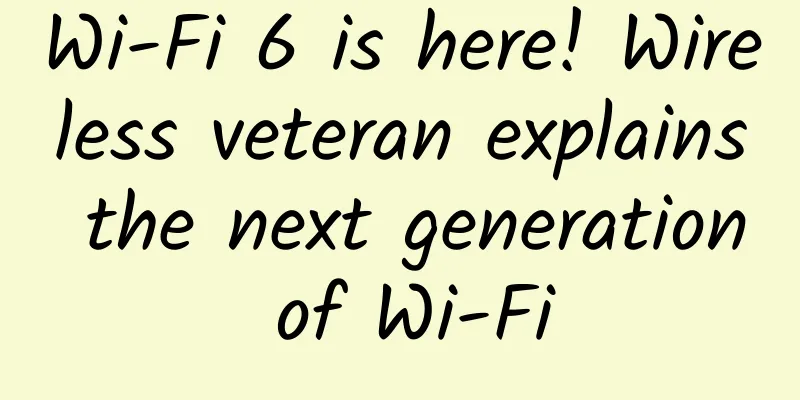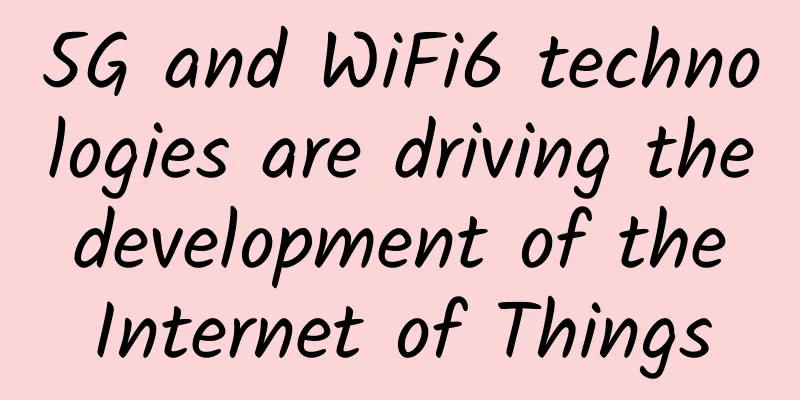Wi-Fi 6 is here! Wireless veteran explains the next generation of Wi-Fi

|
Why is it called Wi-Fi 6? Each new Wi-Fi version brings new features and its acronym, like 802.11.ax, the Wi-Fi Alliance calls it Wi-Fi 6, which stands for the sixth generation of Wi-Fi. Wi-Fi 6 is the next generation of Wi-Fi in the journey of next-generation wireless technology innovation. What can we expect from Wi-Fi 6? Based on the advantages of Wi-Fi 5 (11ac), this standard further enhances the efficiency of spatial reuse through enhanced coding and scheduling methods, allowing each AP to communicate with more devices at the same time, allowing for a higher density of device deployment, lower latency, longer coverage, and higher speed. At the same time, its improvement in low power consumption can extend battery life, which is particularly friendly to battery-powered IoT devices. We will soon feel the experience revolution brought by Wi-Fi 6 in conference venues with tens of thousands of people, high-density offices, wireless production, smart teaching, smart media, and digital scenarios of cities and enterprises. Wi-Fi 6 adds efficiency, flexibility, and scalability. This performance increase enables increased speed and capacity for the next generation of advanced applications, such as seamless mobile roaming, 4K or 8K video, high-definition collaboration applications, fully wireless offices, and the Internet of Things, even in high-density environments. How does Wi-Fi 6 improve the experience? We will use the example of traffic as an example because there is no other analogy that is more appropriate. Roads are like frequency bands for Wi-Fi, which are limited and fixed. Vehicles on the road are like messages for Wi-Fi, which can be large or small and have different transmission rates. 1. 1024QAM QAM (Quadrature Amplitude Modulation): It is a two-dimensional dot matrix modulation method, which converts the data signal "01" into radio waves. Wi-Fi 6 supports 1024QAM, which is 2 to the 10th power bit, a 25% improvement over Wi-Fi 5's 256QAM (2 to the 8th power 8 bits). This is equivalent to optimizing the road, bringing the lanes on the road as close together as possible and increasing the number of lanes without causing traffic congestion. 2. 256QAM 3. 1024QAM 4. OFDMA OFDMA (Orthogonal Frequency Division Multiple Access): Orthogonal frequency division multiple access divides the wireless channel into multiple sub-channels (subcarriers) to form frequency resource blocks. User data is carried on each resource block instead of occupying the entire channel, so that multiple users can transmit in parallel at the same time in each time period. Compared with the OFDM solution of Wi-Fi 5, which dispatches trucks based on orders, regardless of the size of the goods, one truck is dispatched for each order, even for a small piece of goods, which often results in empty carriages, low efficiency, and waste of resources. The OFDMA solution aggregates multiple orders and tries to load trucks fully, greatly improving transportation efficiency. 5. OFDM 6. OFDMA 7. MU-MIMO MU-MIMO (Multi-User Multiple-Input Multiple-Output): Multi-user multiple input and multiple output, which allows the router to communicate with multiple devices at the same time instead of communicating one by one. Wi-Fi 5's MU-MIMO allows the router to communicate with four devices at a time and only supports downlink MU-MIMO. Wi-Fi 6 will allow communication with up to 8 devices at the same time and support both uplink and downlink MU-MIMO. Using a traffic analogy, it is like expanding from 4 one-way lanes to 8 two-way lanes. Multiple devices no longer have to wait in line like many vehicles to exit from one exit. Instead of queuing up one by one, multiple devices can exit/enter from different roads simultaneously and efficiently. 8. Comparison between OFDMA and MU-MIMO Both of them solve the uplink and downlink of multiple users and improve the wireless access density, but in fact there are still big differences between the two. Although both are parallel transmission solutions, they are neither iterative nor competitive, but complementary. Their technical principles are different, and their applicable scenarios are also different. The specific use needs to be determined according to the application type of the service. 9. BSS-Color BSS (Basic Service Set) A 6-bit identifier is added to distinguish the BSSs of the same channel of different APs. The 6-bit is added to the message header. In this way, when an AP receives a message that is not its own, it does not need to decapsulate the entire packet before discarding it as before. It can discard the message as long as the physical guide code is decapsulated to avoid conflicts. This orderly and deterministic use of channel resources greatly improves the overall system performance in dense environments. Using a traffic analogy, it is equivalent to dividing vehicles in the same lane into independent and non-interfering three-dimensional lanes in space according to different transmission purposes, effectively performing spatial reuse. 10. TWT TWT (Target Wakeup Time): Target wakeup time Allows the AP to plan communications with devices and negotiate when and how long to wake up to send/receive data. Terminals can be grouped into different TWT cycles, reducing the time required to keep the antenna powered on to transmit and search for signals, which means reducing battery consumption and improving battery life performance, while also reducing the number of devices competing for wireless resources at the same time after waking up. In the future, smart water meters, smoke detectors, access control in smart building scenarios, machine tools, AGVs, in-and-out scanning devices, and other types of smart devices in smart factory scenarios can all be connected to Wi-Fi. Thanks to TWT, each device can establish a "wake-up protocol" separately. The terminal device will only enter the working state after receiving its own "wake-up" information, and will be in a dormant state for the rest of the time, which can save up to 7 times the battery power consumption. At the same time, this makes it possible for some IoT devices that require high-bandwidth communication, such as smart office equipment. TWT can save up to 7 times of battery power. But the technology won’t help all devices, for example laptops need constant internet access and are therefore unlikely to benefit too much from this feature (perhaps more when going to sleep). The technology is more beneficial for small, low-power devices that occasionally need to update their state. Therefore, TWT technology demonstrates Wi-Fi 6's determination to embrace the Internet of Things. What capabilities does Wi-Fi 6 test Wi-Fi vendors? In summary, Wi-Fi 6 provides many technologies that can effectively improve the efficiency of the entire Wi-Fi network. However, each technology has a lot of room for free play, such as the application of OFDMA technology, how to plan the most suitable subcarrier size; when multiple users transmit at the same time, how to implement corresponding power control for multiple users to ensure that the signals of users in close proximity do not overwhelm users in distant locations, etc. For Wi-Fi 6 to achieve the best user experience, it is imperative that AI technology be introduced to adjust strategies in real time based on changes in the environment and application types of access terminals. This will be a stage for major manufacturers to demonstrate their strength. Ruijie Networks Wi-Fi 6+AI, stay tuned for the next article to learn more. |
<<: The transformation path of communication engineers in the 5G era
>>: 5G infrastructure and the need for end-to-end programmability
Recommend
Rather than calling it a skill, it is better to call it a history of blood and tears. Do you really know how to choose a router?
Whenever I am praised for my shopping skills, I c...
Only 91 base stations were built in two years. Why is 5G millimeter wave so difficult?
[[405114]] This article is reprinted from the WeC...
What is 5G? How is it better than 4G?
[[264309]] 5G networks will increase wireless net...
The number of IoT users of the three major operators exceeds 1.1 billion, and the Internet of Everything brings trillions of connection value
5G opens a new era of the Internet of Everything....
Efficient transfer tips, revealing the pros and cons of Rsync and SCP, helping you make a wise choice!
In daily operation and maintenance work, file tra...
How to become a better person? Huawei Elite Competition helps ICT talents break out of their cocoons and become butterflies
[51CTO.com original article] On the last Saturday...
5G accelerates the process of 2G/3G network withdrawal in my country
Recently, British mobile operator Three UK has de...
CloudServer: $12/quarter-single core, 4G memory, 30G NVMe disk, 5TB/10Gbps New York data center
CloudServer is a foreign hosting company founded ...
AlphaVPS: AMD EYPC KVM monthly payment starts from 3.99 euros, large hard disk KVM annual payment starts from 15 euros
AlphaVPS is a foreign hosting company established...
Fearing that 5G deployment will affect aviation safety! US aviation agencies and telecommunications agencies are in dispute
Although 5G (fifth-generation mobile communicatio...
WiFi passwords are always cracked? Here are some tips to help you avoid WiFi hacks
With the development of mobile Internet technolog...
The creator of the World Wide Web has a plan for a better global network, but he needs help
According to foreign media CNET, Sir Tim Berners-...
It’s too late when the crisis happens! Only by following this zero-trust principle can we be stable enough
Enterprises need to monitor and measure the integ...
The emergence of 6G technology: growth opportunities for modern industry
The potential of 6G technology will become appare...
Huawei Cloud 12.12 Membership Festival invites you to join the carnival. In the 5G era, Huawei Cloud is the right choice!
[51CTO.com original article] Guess what the first...









